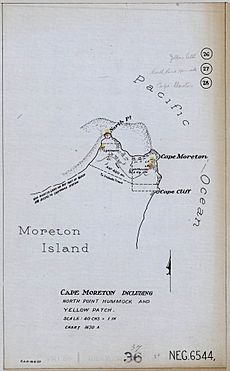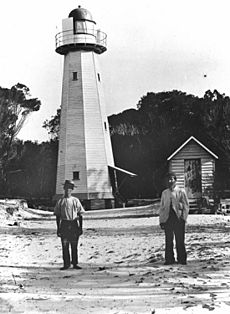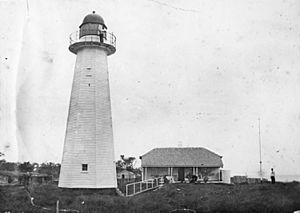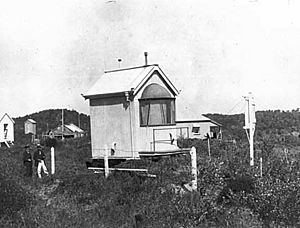Moreton Island lighthouses facts for kids
Moreton Island is a big sandy island in Moreton Bay, off the coast of South East Queensland, Australia. It was very important for ships trying to get into Moreton Bay and reach Brisbane. Because of this, at least five lighthouses were built on the island.
The first lighthouse was Cape Moreton Light, built in 1857. It was the very first lighthouse in Queensland! After that, four more lighthouses were built from the 1860s onwards. These were at Comboyuro Point, North Point, Cowan Cowan Point, and Yellow Patch. Some of these lighthouses, like Comboyuro Point Light, Cowan Cowan Point Light, and Yellow Patch Light, had to be moved. This happened because the coastline changed due to coastal erosion. Out of all five lighthouses, only Cape Moreton Light is still standing and working today.
Contents
Why Lighthouses Were Needed
In 1825, Brisbane started as a penal settlement, which was a place where prisoners were sent. Even though it was a bit risky, ships usually entered Moreton Bay through the southern entrance. This was between Moreton Island and North Stradbroke Island. It was a shorter shipping route and often had better conditions for ships.
So, in 1825, the southern entrance was marked to guide ships. A pilot station was set up at Amity Point on North Stradbroke Island in 1827. A pilot station is where expert sailors, called pilots, would guide ships safely into the bay.
People started thinking about using the northern entrance in the 1830s. But it wasn't until 1842 that more ships began to use it. This was because Moreton Bay became a free settlement, meaning more people and goods were coming and going.
To help ships, buoys were placed to mark the northern entrance in 1846–1847. By 1848, the pilot station moved to Cowan Cowan on Moreton Island, and then to Bulwer. From then on, the northern entrance was seen as the main way into Moreton Bay.
Cape Moreton Light: Queensland's First Lighthouse
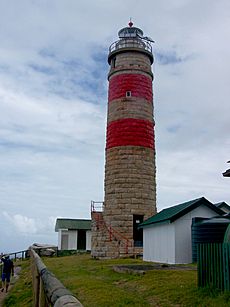
Cape Moreton Light is found on Cape Moreton, which is a rocky point at the very northeast tip of Moreton Island. This was the first lighthouse built to guide ships into the northern entrance of Moreton Bay.
The New South Wales Government built this lighthouse. At that time, Queensland was still part of New South Wales, before it became its own state in 1859. People in Brisbane asked for a lighthouse in 1850, and it was finally lit up in February 1857.
Out of all five lighthouses on Moreton Island, Cape Moreton Light is the only one that still exists and works. In 1993, it was updated to use solar power. Now, it flashes four white lights every 20 seconds. Each flash is separated by 3.3 seconds. This light can be seen from about 15 nautical miles away.
Comboyuro Point Light
The Comboyuro Point Light was also known as Comboyuro Light. It was located at Comboyuro Point, on the northwest tip of Moreton Island. This lighthouse, like some others, had to be moved because the coastline changed over time.
North Point Light
The North Point Light was also called North Point Hummock Light. It was located on North Point, which is the most northern part of Moreton Island.
Cowan Cowan Point Light
The Cowan Cowan Point Light was also known as Cowan Cowan Light or Cowan Point Light. It was located on Cowan Cowan Point, which is on the western side of Moreton Island. This lighthouse also had to be moved at one point due to changes in the coastline.
Yellow Patch Light
The Yellow Patch Light was located about 0.5 miles southwest of North Point. An old book from 1877 describes it as a wooden tower, 43 feet tall, that showed a steady white light.
The Yellow Patch Light also had problems with coastal erosion. In 1882, it had to be moved 300 feet to the northeast. By 1891, it had been moved four times!
A list from 1909 says it was a square wooden lightroom. It had a special lens system that showed red and white light in different directions. This light could be seen from about 11 nautical miles away. The List of Lights from 2010 does not show a light at this location anymore, meaning it is no longer active.


